The Sea Turtle Conservancy does essential work to protect endangered sea turtles that nest along Tortuguero’s beaches. Just outside the main area of town is their visitors center. Here, at the small museum, you can learn a little bit about the organization and how they are helping sea turtles. In this post, we’ll tell you what to expect on a visit to the Sea Turtle Conservancy Visitor Center in Tortuguero.

Background
The Sea Turtle Conservancy is the world’s oldest sea turtle research and conservation group. It was founded in 1959 by the biologist Dr. Archie Carr to save sea turtles from extinction through science-based conservation.
Over the last 60+ years, the organization has done important research into sea turtles and the threats they face. They have applied this knowledge in Costa Rica and other key locations around the world to help the sea turtle population recover.
Their work focuses on green sea turtles. Interestingly, Tortuguero has the largest green turtle nesting population in the entire world.
You can learn more about the Sea Turtle Conservancy on their website.

Short Tour
After a short walk from the main area of Tortuguero, we stepped off the sandy beach path and entered the Sea Turtle Conservancy Visitor Center.
Alexa, a volunteer from Mexico, asked if we would like to walk around the small museum by ourselves or have him come to give some information. We said we love to learn from him.

General Information
Alexa started by explaining that three types of turtles lay their eggs along Tortuguero’s beaches, the leatherback, green sea turtle, and hawksbill. Loggerhead turtles also come but there have only been 16 in the last 50 to 60 years.
He pointed to a real turtle skull to help us get to know their size. Interestingly, hawksbill turtles have a distinctive beak. They use it to eat coral. Our young sons got to touch the old skulls, which they thought was really cool.

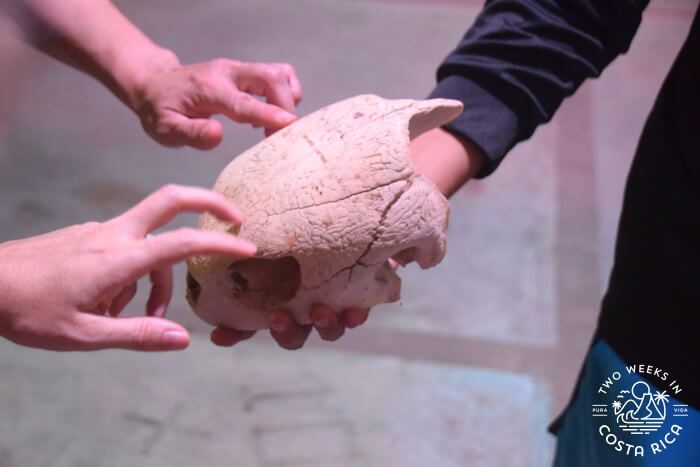
Threats to Turtles
Alexa then went on to teach us about the dangers affecting sea turtles. These include habitat loss, illegal fishing, climate change, and ocean plastic. Leatherbacks, for example, eat plastic bags because they look like jellyfish. In Costa Rica, poaching is another big problem. Locals take eggs from nests to eat or sell them.
Life Cycle
Alexa also taught us about the turtle life cycle.
After the mother turtle lays her eggs, the eggs develop in the sand for 60 to 70 days before hatching. The sex of the turtle, we learned, is determined by the sand temperature. With climate change and increasing temperatures, more turtles are being born female, he explained.
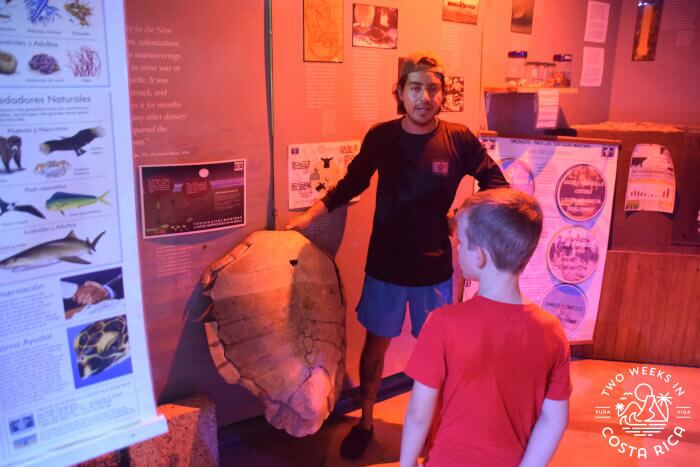
Work of the Volunteers
Finally, Alexa taught us about some of the organization’s work in Tortuguero. One of their most important roles is to protect the nests from poachers. We learned that this can be a dangerous job, as poachers are often not willing to back down.
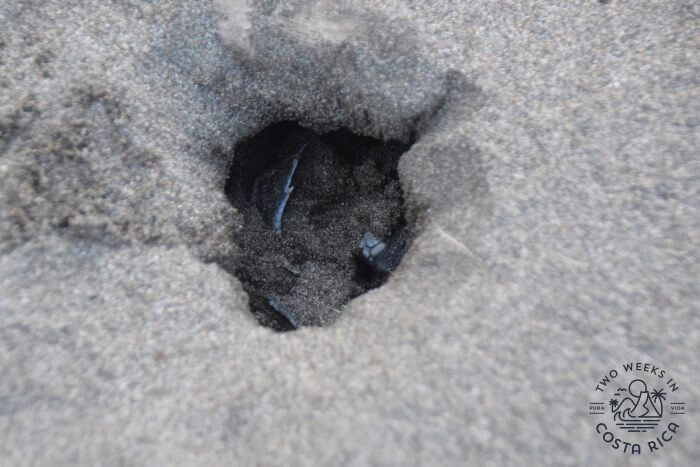
The volunteers also track nesting. When a turtle comes to nest, they use a counter to record the number of eggs. They also measure the turtle, tag it with a metal clip, and microchip it. This data is then put into the computer and used for tracking.
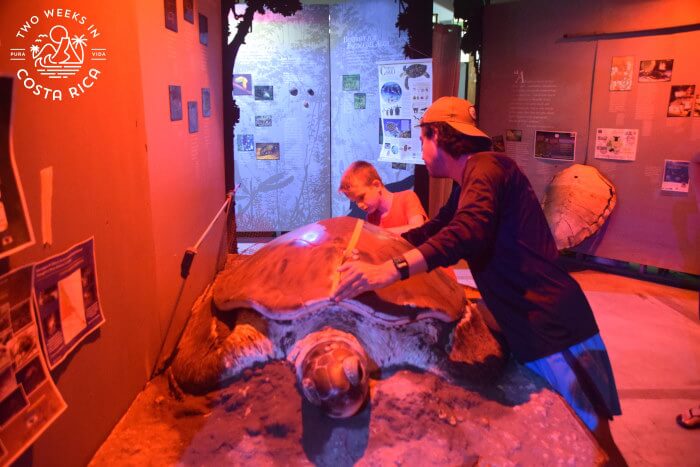
He told us that just the other day, a turtle came to nest that had first come to that beach about 20 years ago. The turtle was estimated to be around 42 years old now. Turtles return to the same beach that they were born to nest.
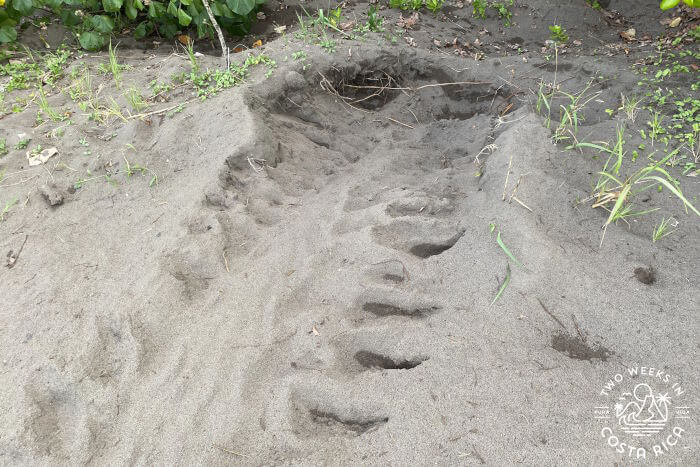
Video
After a quick 15 or so minute tour, we walked to the building next door for a short video. It taught us more about the Sea Turtle Conservancy organization and how it got started.

We also learned more about their work with the local community. This has been vital to getting the turtle population numbers back up. One of their main goals has been to teach locals to protect the sea turtles rather than poach them, as the turtles bring tourists, and thus, jobs.
Tourism is the main industry in the village of Tortuguero, which draws thousands of visitors every year because of its amazing wildlife viewing.
The video explained that the Sea Turtle Conservancy helped establish protocols for night turtle watching. We have done a turtle watching tour in Tortuguero and were very impressed with how the tour was run. We didn’t feel like we were disturbing the nesting process like on some other turtle tours in Costa Rica.
Planning Your Visit to the Sea Turtle Conservancy Visitor Center
Cost
$2.50 per person
Hours
Open daily, 8:00 a.m. to 5:00 p.m. They are closed from 1-2 p.m. for lunch.
Souvenirs
They also sell T-shirts, bags, cups, and other souvenirs with the Sea Turtle Conservancy logo. They’re a cute take home item and help support their cause.
Conclusion
The Sea Turtle Conservancy Visitor Center in Tortuguero is a nice, quick stop if you have a free half hour. You’ll learn a lot about the concerns facing Tortuguero’s most iconic animal and it’s an easy way to help.
Have a question about visiting the Sea Turtle Conservancy or you have been? Leave a comment below.
Looking for more information to plan your trip? Check out these posts:
Tortuguero Sea Turtle Nesting Tour: If you want to see a turtle, a night turtle watching tour is a great option. Learn about our experience.
Cerro Tortuguero: Hike and Viewpoint – The short hike to Cerro Tortuguero offers one of the best views of Tortuguero and its surrounding rainforest.
Ara Manzanillo: A Great Green Macaw Tour – If you’re heading to the southern Caribbean coast, be sure to check out Ara Manzanillo. They are doing amazing work to protect endangered macaw parrots.
